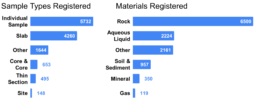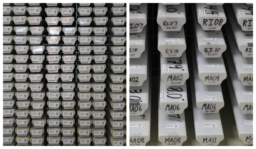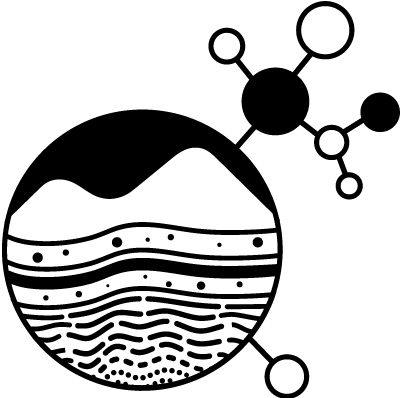SESAR 7.3.0 Released
July 2019.
SESAR version 7.3.0 is released
We have released a new version of SESAR. The release includes a number of enhancements and improvements. Enhancements include updates to the sample search tool and IGSN landing pages. The general improvements include minor bug fixes in the batch registration process and adding additional validations to the registration process.
You can read about all of the enhancements and improvements at the SESAR Release Notes page.
If you have any questions or comments, please contact info@geosamples.org.
SESAR² Workshop at Goldschmidt 2019
June 2019
SESAR will co-host a workshop “Vive les Samples! Geosample data management and visualization for the discerning geochemist!” at the Goldschmidt Conference in Barcelona on August 18th from 8:30 am – 12:30 pm. Please register here.
This workshop will be of interest to all geochemists who collect samples and have an interest in extending the impact of their samples. Presentations and discussion will focus on:
- learning how to register samples with a unique and persistent identifier and connecting them to data publications and datasets;
- best practices for keeping samples safe and accessible for the long term;
- easy-to-implement techniques to effectively communicate through visualization the rich information resource your samples represent;
- identifying relevant institutional repositories for your sample data;
- how professional organizations and publishers are facilitating information connectivity and responsible sample management;
- demonstrating how sample management can serve as a basis for a great Data Management Plan;
SESAR² Newsletter | May 2019
May 2019, Vol 2 Newsletter
May 2019
This newsletter summarizes new features and improvements in the System for Earth Sample Registration (SESAR²). Click on the links below for more detailed information.
New Samples in SESAR²
13,233 samples have been registered in SESAR² since February 2019. Browse the complete SESAR² catalog with more than 4.3 million samples.
Tutorials & Help Pages
Don’t forget to check out our help page for information and tutorials about using SESAR² to register, update, and manage your samples.
SESAR² Sample Type Highlights

SESAR² Community
- SESAR² will co-host a workshop “Vive les Samples! Geosample data management and visualization for the discerning geochemist!” at the Goldschmidt Conference in Barcelona on August 18th from 8:30-12:30. This workshop will be of interest to all geochemists who collect samples and have an interest in extending the impact of their samples. Please register here.
- EarthChem and SESAR² presented at the CZIMEA Toolkit workshop, an EarthCube cyberinfrastructure training and tool assessment workshop which aims to bring together tool developers and early career Critical Zone scientists.
- Join us on twitter @igsn_info!
IGSNs in the Literature
- Gonzalez et al., 2019, Characterization of soil profiles and elemental concentrations reveals deposition of heavy metals and phosphorus in a Chicago-area nature preserve, Gensburg Markham Prairie. doi: 10.1007/s11368-019-02315-5.
- Check out the Gensburg Markham Prairie site and related samples in SESAR². Characterization and elemental analyses of soil cores are also published in the EarthChem Library.
- Barnes et al., 2019, The role of the upper plate in controlling fluid-mobile element (Cl, Li, B) cycling through subduction zones: Hikurangi forearc, New Zealand. doi: 10.1130/GES02057.1.
- Click here to browse the spring water samples from the Hikurangi subduction zone in SESAR².
- Giguet-covex et al., 2019, New insights on lake sediment DNA from the catchment: importance of taphonomic and analytical issues on the record quality. doi: 10.31223/osf.io/cnh3r.
SESAR Newsletter | February 2019
Newsletter February 2019, Vol 1
February 2019
This newsletter summarizes new improvements and features in the System for Earth Sample Registration (SESAR²) as well as recent outreach and user highlights. Click on the links below for more detailed information.
Samples Added
Since November 5,011 samples were registered in SESAR². Browse the complete SESAR² catalog with more than 4.3 million samples.
Recent SESAR² Improvements
SESAR² v.7.2.2 was released in November 2018. This new version introduced improved validation and new functionality for the Sub-Object Type and Classification fields and implemented a new version (4.0) of web service schema. See more release notes here.
SESAR² Community
- The SESAR² team attended the AGU Fall Meeting held in Washington D.C from December 10-14, 2018. See more information below about our presentations at AGU, which included presentations about the IGSN and SESAR² and participation in a town hall regarding geochemical data standards. If you were not able to catch up with us at AGU, contact us at info@54.224.199.193 with questions or comments about our resources.
- IGSN: Toward a Mature and Generic Persistent Identifier for Samples: This presentation discussed the evolution of the IGSN and our efforts to redesign and improve its existing organization and technical architecture. Slides from this talk can be found here.
- Increasing the Impact of Your Research by Enabling Persistently FAIR Physical Samples: The System for Earth Sample Registration (SESAR²): This poster discussed the benefits of using IGSNs and SESAR², and how SESAR² has grown beyond individual investigators to include repositories, museums, and many large-scale scientific initiatives.
- Building a Global Network of Geochemical Data: This townhall discussed developing geochemical data standards in the Earth Sciences (and the IGSN as an existing standard that has improved discoverability) and opportunities for a global geochemical data network.
- Dr. Kerstin Lehnert and SESAR² participated in PIDapalooza 2019, a conference dedicated to persistent identifiers (PIDs). Dr. Lehnert gave a presentation titled “Transitioning an Identifier System to Persistence” where she discussed the recent Sloan-funded effort to develop a mature organizational and technical structure for the IGSN that is scalable and extensible to other domains, ensuring persistence.
- SESAR² participated in the annual assembly of members of the International Implementation Organization for the IGSN (IGSN e.V.). The objective of the IGSN e.V. is to implement and promote standard methods for locating, identifying, and citing physical samples with confidence by operating an international IGSN registration service with a distributed infrastructure for use by and benefit to its members. Membership in the IGSN Implementation Organization is open to organizations who wish to run their own IGSN allocating service.
- Join us on twitter @igsn_info!
User Spotlight
- In this edition we spotlight Nichole Anest and the team at the Lamont-Doherty Core Repository. The Lamont-Doherty Core Repository (LDCR) contains one of the world’s most unique and important collections of scientific samples from the deep sea. Sediment cores from every major ocean and sea are archived at the Core Repository, which contains approximately 72,000 meters of core and associated metadata. Besides their mission to provide long-term curation and archiving of samples and cores, the Core Repository also fulfills sample requests, assists investigators in sample collection activities, and works tirelessly to educate teachers, students, and the public about the important role science and the Core Repository play in building a better understanding of Earth processes. We caught up with Nichole to learn more about how the Core Repository uses the IGSN and SESAR² to manage their samples, and to explore some of their exciting sample collections. Read more below:
- Why do you use SESAR²? We use SESAR² because it makes it possible to track samples through time and publications. I get many students requesting samples that someone used in a paper years to decades ago but the information in the paper about the samples is usually limited or non-existent. So, we have to go back through our paper sampling histories to locate the PI, what core(s) and at what intervals they sampled, and try to piece together what samples’ data were used for the published work. The use of IGSNs makes these sort of sample requests much easier as well as giving “automatic” acknowledgement to the repository where the samples came from.
- Sample group highlight: There are about two hundred cores that were taken by the Bureau of Ocean Energy Management (BOEM), part of the US Dept of the Interior, to look for near-shore sand deposits. They wanted to identify where beach sand was transported after major coastal storms (such as Irene and Sandy) and see if it is feasible to use it to replenish the beaches after such storms. Check out the BOEM cores in SESAR² which include core photos as well as grain size data.

Continental Scientific Drilling Holes Registered in SESAR
May 2018
Nearly 7,000 holes drilled across the globe in collaboration with the Continental Scientific Drilling Coordination Office have been registered in SESAR. These holes now have persistent and globally unique identifiers (IGSNs) and can be linked to core samples extracted from the holes. Check them out in the SESAR² Catalog by searching Set Name/IGSN -> IGSN begins with “CDR”. These holes were registered as part of Open Core Data, an NSF-funded project that is radically improving discoverability, accessibility, citeability, preservation, and integration of data from past, current, and future drilling and coring projects.

Connecting Data and Real-World Samples
January 2018
A recent EOS Meeting Report describes last year’s International Symposium on Linking Environmental Data and Samples, which gathered more than 70 participants from a variety of Earth and environmental disciplines such as the solid Earth sciences, marine science, oceanography, soil science, ecosystems science, biodiversity, and remote sensing. Researchers, including SESAR²’s Dr. Kerstin Lehnert, considered whether a uniform approach to data representation could be applied to disciplines and projects with widely varying approaches to sampling. Various sessions allowed attendees to discuss their motivations for linking samples and data, explore technical approaches to Web linking and identifiers, and evaluate the challenges in the adoption of common standards across different disciplines and sectors where incentives may vary widely. Participants agreed that relationships between samples, parts of samples, and sampling artifacts must be recorded to allow resulting observations to be related back to the world. Ultimately, the meeting achieved its theme of “linking” by bringing together multiple disciplines to improve our understanding of how linked data can work in practice for environmental samples and data.
Undergraduate Projects Fuel Access to Scientific Collections
November 2017
Undergraduate students in the Computer Sciences Department at the College of Charleston are developing open-source software applications that make it easier to document and register scientific samples in the System for Earth Sample Registration (SESAR) to improve discovery and access to these valuable research resources for future use. The students are working under the direction of Dr. Jim Bowring in the Cyber Infrastructure Research & Development Lab for the Earth Sciences (CIRDLES). Four of the students recently presented their work at the 2017 Geological Society of America Annual Meeting. MARS, Middleware for Assisting with the Registration of Samples, is highlighted below.
MARS: Middleware for Assisting with the Registration of Samples
Tia Curry is the latest student from the CIRDLES lab to work on developing MARS, an open-source, cross-platform desktop and web application that streamlines the bulk registration of samples in the SESAR² sample registry. The application, which is still in development, allows investigators to register samples using their own preferred sample metadata file, rather than having to rearrange sample metadata to fit into the SESAR² batch registration template. Users should also supply a mapping file that maps SESAR² metadata fields to fields in their sample metadata files. MARS takes advantage of existing SESAR² sample registration web services to validate and register samples. Once IGSNs are assigned, they are automatically inserted back into the user’s original sample metadata file, eliminating the need to copy and paste or wait for an email. Check out Curry’s recent presentation about MARS here.
MARS was originally developed to assist with the registration of thousands of legacy cores archived at the Scripps Institution of Oceanography. For Geological Collections Manager Alex Hangsterfer, the time required to rearrange countless spreadsheets worth of metadata in order to upload those spreadsheets to SESAR² was simply not feasible. Although MARS was initially prototyped to facilitate the registration of the Scripps core collection, its highly extensible architecture will allow broad adoption.
The idea for MARS originally came about when Hangsterfer shared her challenges with Bowring and others at the Kickoff Meeting of the EarthCube iSamples Research Coordination Network (RCN) in 2015 and from there, a working group was formed to investigate tools to lower the barriers to use of the International Geo Sample Number (IGSN), the globally-unique identifier for physical samples. The IGSN, itself, has been recognized as an important tool for uniquely identifying samples in the lab and in the literature, as well as for linking samples to data, publications, and funding awards. Because resources can vary widely from one organization to another, open-source and extensible development of tools like MARS is immensely important for facilitating widespread adoption and use of the IGSN. Efforts like the iSamples RCN are also pivotal for providing a forum for diverse stakeholders, like computer scientist Bowring and geological collections manager Hangsterfer, to engage with one another. The RCN also provided modest student support to carry out development.
Copernicus Publications Recommends IGSN
May 2017
Copernicus Publications, publisher of nearly 40 peer-reviewed open-access scientific journals, now encourages the use of the International Geo Sample Number (IGSN) in articles to promote reproducibility of scientific research. Copernicus allows authors to connect their publications with related “assets”, such as other research data, model code, videos, and now physical samples via the IGSN. Authors are encouraged to include IGSNs for any physical samples in manuscript text, as well as cite the IGSN in the reference list and include a statement about sample availability. To learn more, see the Copernicus news release or the Copernicus Manuscript Preparation Guidelines for Authors (sample availability section).
New SESAR Video Tutorials
March 2017
SESAR has released 4 video tutorials listed below on sample registration on the IEDA YouTube Channel. The videos are aimed at simplifying the registration process and addressing frequently-asked questions. We plan to continue to grow our video tutorial collection, so please keep an eye on the SESAR YouTube Playlist for more. Also see our tutorials section of the website. If you have questions or suggestions for new tutorials, please contact us at info@geosamples.
- How to get a SESAR Account
- How to Download a SESAR Batch Registration Template
- How to Complete a SESAR Batch Registration Template
- How to Upload a SESAR Batch Registration Template
Saving Marine Archives Using the IGSN
March 2017
In a recent EOS Project Update, the Marine Annually Resolved Proxy Archives (MARPA) project became the most recent group to recommend the use of the International Geo Sample Number (IGSN) for uniquely identifying and properly documenting physical samples. MARPA specifically recommended the use of IEDA’s sample registry, SESAR². The article highlighted the ease of registering and documenting samples in SESAR² and showcased some of the SESAR²’s sample management tools (label printing, etc.). The MARPA project is an NSF EarthCube initiative that aims to build consensus around best practices for sample and data sharing, particularly within the the paleoceanography and paleoclimatology communities, where sample and data management has largely been left up to individual researchers, with samples stored in individual labs and documented only on personal computers or in field notebooks. Read the full article here.
As pictured above, the use of SESAR² and the IGSN allowed the Lamont-Doherty Core Repository to better document, label, and organize their sample (in this case, coral) collections.


